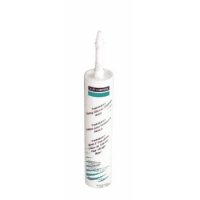How to use Dow HVAC/R Silicone Sealant
- Prepare surface by cutting out and removing any/all old caulk for repair applications.
- For cleaning purposes, apply Dow HVAC/R silicone sealant solvent to a lint-free cloth, wipe vigorously to remove dirt and residues from the surfaces you intend to bond. Next, use a dry cloth to remove any remaining solvent and residue for the best possible cleaning. Repeat this step, if necessary. All surfaces must be clean, dry, oil and frost-free in order to obtain superior results. Dow suggests using solvents such as isopropyl alcohol, toluene, xylene, naphtha or similar agents. CAUTION: Always wear gloves and follow safety precautions and directions on solvent container.Never use gasoline or kerosene.
- Install back-up spacing material for better filling, especially if width exceeds 1/2" in order to maximize bonding results. Open-cell polyethylene foam backer rod can also be used.
- Next, apply masking tape to those areas that are adjacent to the joint to ensure straight and narrow bead lines and easy cleanup. Remove all masking tape immediately after the bead is completed and before a skin forms.
- Now, open the cartridge; cut snub nose above the threads, reattach and cut nozzle to desired size. Insert the cartridge into a caulking gun.
- You are now ready to apply. Extrude the Dow HVAC/R silicone sealant solvent with a smooth and steady motion and ensure to completely fill the joint cavity before going to the next step.
- It's "Tool Time"! Tool the sealant immediately after application and before the skin process takes place. Remember, you only have 5 to 10 minutes of tooling time! Remove all masking tape immediately after tooling.
- Replace the Dow HVAC/R silicone sealant solvent cartridge cap.
Cleanup Instructions
- Cleanup should start immediately after sealant has been applied, tooled and all of the masking tape has been removed.
- Make sure that you wear solvent-resistant gloves snd wipe off anyexcess sealant from surfaces and tools with a solvent moistened cloth within 10 minutes of application.
- If excess sealant is completely cured, you will then need to carefully cut or scrape it off.
- Avoid contact of uncured sealant with skin and clothing. If contact does occur, wipe with clean rags and wash off all residue with water.
NOTES:
- Be aware that the shelf life of this silicone sealant is 27 months from the date of manufacture that is stamped on each cartridge
- Apply sealant at temperatures between -20 and 122 degrees F to obtain best results.

